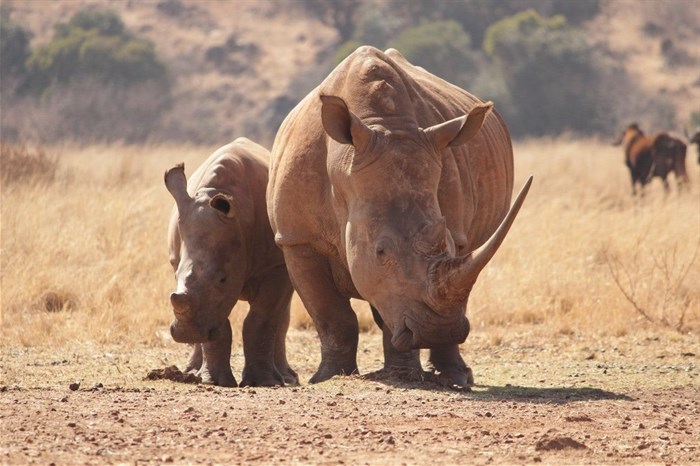
Image source: Nicole Kruger from
PexelsWhat is the rhino horn trade?
Rhino horn is not particularly special in terms of its biochemistry. Its composition is close to that of various other mammal horns, hooves and hair. Despite this, and the ban on international sales, rhino horn continues to be illegally trafficked from Africa to Asia – principally China and Vietnam – where there is a demand for the horn. Rhino horn is used as a status symbol (ownership is associated with affluence), linked with use in traditional Chinese medicine and used as an aphrodisiac.
Rhino are poached (killed) for their horn, which is then illegally traded. With the three Asiatic rhino species on the precipice of extinction, the main sources of rhino horn today are the African rhino: the black rhino and the white rhino. Today, South Africa has fewer than 23,000 rhino left of a historical population of 500,000. In 2023 alone, 449 rhino were lost to poaching.
Rhino can be protected against poaching if they are guarded or monitored, moved to areas where the poaching risk is lower, or through veterinary surgeons removing their horns under anaesthesia. A rhino with horn removed is in theory less likely to be poached as, with a much shorter horn, the financial reward to the poacher is greatly diminished.
However, data on the effectiveness of de-horning as a conservation tool is limited and results are mixed. The rhino horn also grows back, meaning that the rhino needs to be dehorned regularly to reduce the poaching risk. These harvested horns are often stored instead of being destroyed.
What is the rhino horn stockpile?
Rhino horn obtained by regular harvesting, horn from natural rhino deaths, and horn confiscated by law enforcement is stored in stockpiles by rhino owners, investors and government. In 2020, when the last official stockpile figures were released, the South African government stockpile stood at 27,641kg, with 47,544kg in private hands. These stockpiles are supposed to be stored securely to prevent the horn from being stolen and sold on the illegal market.
Rhino horn can be traded legally within South Africa, under permit, but there is no local demand. Previous hopes of a rhino-horn tourism industry, where visitors would travel to legally consume rhino horn in South Africa, have not transpired.
Why stockpile rhino horn when there is no legal international market, and therefore no economic value to it? The chief motive for stockpiling rhino horn seems to be the hope that the international market will reopen in future. Private landowners in South Africa may have invested in rhino, and stockpiled harvested horn, speculating that a future international legal market will provide financial rewards.
The South African government itself lobbied for a lifting of the international ban on trade in rhino horn at the 17th Conference of the Parties to the Convention on International Trade in Endangered Species in 2016. However, the conference upheld the ban on trade. If the ban was lifted, clearly a lot of money could be made from selling the vast amount of stockpiled horn. On the black market, rhino horn is bought and sold for between US$10,694/kg and US$22,257/kg in Vietnam.
Why is the rhino horn stockpile a problem?
In spite of the ban on international trade, and the legal requirement for secure storage, rhino horn has been diverted from South African stockpiles into the illegal global wildlife trade.
A South African government stockpile was the target of theft in 2023, losing 51 horns to thieves who broke into the storage area. The South African government’s statistics also indicate a decrease in rhino stockpiles of over 4,000 horns between 2019 and 2020.
Akhona Matshoba and Tanisha Heiberg 7 Jun 2021
Seizures of illegal rhino horn shipments have been found to contain rhino horn from South African stockpiles – both private and government. In South Africa, each rhino horn removed from rhino should be microchipped; this unique ID enables rhino horn to be traced to its source.
The EMS report argues that the stockpiles contribute to creating a demand for more accessible rhino horn, in larger amounts. This can lead to poaching and costly knock-on effects such as a greater investment in rhino protection, and danger to those guarding the rhino. Destroying rhino horn stockpiles would signal a commitment to no-trade and symbolise the worthlessness of rhino horn as a commodity.
What is the solution to the rhino horn stockpile problem?
The pro-trade side want a future with a legal international trade in rhino horn, and argue that this is the route to saving the rhino. The no-trade side believe a legal trade in rhino horn would make a future for free-living wild rhino even more challenging than it is now. Unfortunately, these opposing visions of a future for rhino are not compatible. The rhino are caught in a policy no-man’s-land.
I believe that the key to saving the rhino is demand reduction. Promoting behaviour change among consumers, for example via publicity and education campaigns, by turning rhino horn into a badge of shame rather than a medallion of status would undermine the market demand.
Diminishing demand for rhino horn would ultimately remove the incentive for poaching rhino. It would also remove any incentive to private land owners to farm rhino for their horn. I am against “saving” the rhino by domesticating them: I want to see wild animals living a natural life in their natural environment – contributing to the ecosystem. Symbolic funeral pyres of burning rhino horn may be the best way forward for rhino conservation.
This article is republished from The Conversation under a Creative Commons license. Read the original article.





































